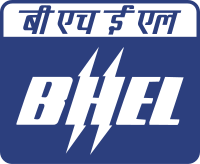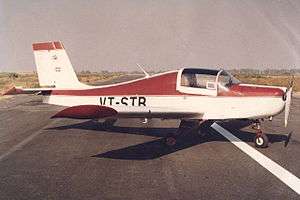Bharat Heavy Electricals Limited
Bharat Heavy Electricals Limited (BHEL) owned and founded by the Government of India, is an engineering and manufacturing company based in New Delhi, India. Established in 1964, BHEL is India's largest power generation equipment manufacturer. As of 2020 BHEL's revenue stood at ₹22,066.64 crore (US$ 3.1 billion) and their net income stood at ₹-1,472.97 crore (US$ -210 million).
 | |
| Public Sector Undertaking | |
| Traded as | BSE: 500103 NSE: BHEL |
| ISIN | INE257A01026 |
| Industry | Electrical equipments |
| Founded | 1964 |
| Founder | Government of India |
| Headquarters | , |
Area served | Worldwide |
Key people | Nalin Shinghal (Chairman & Managing Director) |
| Products | Gas and Steam Turbines Boilers Electric Motors Electric Locomotives Generators Heat Exchangers Switchgears and Sensors Automation and Control Systems Power electronics Transmission systems |
| Revenue | |
| Total assets | |
| Total equity | |
| Owner | Government of India (63.17%) |
Number of employees | 39,821(2019)[2] |
| Website | www |
History
BHEL was established in 1964 ushering in the indigenous Heavy Electrical Equipment industry in India. Heavy Electricals (India) Limited was merged with BHEL in 1974.[3] In 1991, BHEL was converted into a public limited company. Over time, it developed the capability to produce a variety of electrical, electronic and mechanical equipments for all sectors, including transmission, transportation, oil and gas and other allied industries.[3] However, the bulk of the revenue of the company is derived from sale of equipment for power generation such as turbines, boilers, etc. As of 2017, BHEL supplied equipment contributed to about 55% of the total installed power generation capacity of India.[4] The company has also supplied thousands of Electric Locomotives to Indian Railway,[3] as well as defence equipment such as the Super Rapid Gun Mount (SRGM) naval guns manufactured in partnership with the Indian Ordnance Factories [5] and Defence Simulators to the Indian Armed Forces....
Operations


BHEL is engaged in the design, engineering, manufacturing, construction, testing, commissioning and servicing of a wide range of products, systems and services for the core sectors of the economy, viz. power, transmission, industry, transportation, renewable energy, oil & gas, and defence.
It has a network of 17 manufacturing units, 2 repair units, 4 regional offices, 8 service centres, 8 overseas offices, 15 regional centres, 7 joint ventures, and infrastructure allowing it to execute more than 150 projects at sites across India and abroad. The company has established the capability to deliver 20,000 MW p.a. of power equipment to address the growing demand for power generation equipment.[6]
BHEL has retained its market leadership position during 2015–16 with 74% market share in the Power Sector. An improved focus on project execution enabled BHEL record its highest ever commissioning/synchronization of 15059 MW of power plants in domestic and international markets in 2015–16, marking a 59% increase over 2014–15. With the all-time high commissioning of 15000 MW in a single year FY2015-16, BHEL has exceeded 170 GW installed base of power generating equipments.[7]
It also has been exporting its power and industry segment products and services for over 40 years. BHEL's global references are spread across over 76 countries across all the six continents of the world. The cumulative overseas installed capacity of BHEL manufactured power plants exceeds 9,000 MW across 21 countries including Malaysia, Oman, Iraq, UAE, Bhutan, Egypt, and New Zealand. Their physical exports range from turnkey projects to after sales services.[8]
Initiatives

BHEL's investment in R&D is amongst the largest in the corporate sector in India.
During the year 2012–13, the company invested about Rs. 1,252 Crore on R&D efforts, which corresponds to nearly 2.50% of the turnover of the company, focusing on new product and system developments and improvements in existing products. The IPR (Intellectual Property Rights) capital of BHEL grew by 21.5% in the year, taking the total to 2170.
The Corporate R&D division at Hyderabad leads BHEL's research efforts in a number of areas of importance to BHEL's product range. Research & product development (RPD) Groups for each product group at the manufacturing divisions play a complementary role. BHEL has established Centres of Excellence for Simulators, Computational Fluid Dynamics, Permanent Magnet Machines, Surface Engineering, Machine Dynamics, Centre for Intelligent Machines and Robotics, Compressors & Pumps, Centre for Nano Technology, Ultra High Voltage Laboratory at Corporate R&D; Centre of Excellence for Hydro Machines at Bhopal; Power Electronics and IGBT & Controller Technology at Electronics Division, Bengaluru, and Advanced Fabrication Technology and Coal Research Centre at Tiruchirappalli.
BHEL has established four specialized institutes, viz., Welding Research Institute (WRI) at Tiruchirappalli, Ceramic Technological Institute (CTI) at Bangalore, Centre for Electric Traction (CET) at Bhopal and Pollution Control Research Institute (PCRI) at Haridwar. Amorphous Silicon Solar Cell plant at Gurgaon pursues R&D in Photo Voltaic applications.[9]
Significantly, BHEL is one of the only four Indian companies and the only Indian Public Sector Enterprise figuring in 'The Global Innovation 1000' of Booz & Co., a list of 1,000 publicly traded companies which are the biggest spenders on R&D in the world.[10]
Criticism
BHEL is to construct 1340-megawatt coal power plant in Rampal which is close to the Sundarban mangrove forest for Bangladesh-India Friendship Power Company(Pvt.) Limited (joint venture between NTPC Limited and Bangladesh Power Development Board). The project has faced criticism for the environmental impact and the potential harm to the largest mangrove forest in the world.[11][12][13][14][15] In 2017 Norway's sovereign wealth fund removed BHEL from its investment portfolio over concerns about the Rampal coal plant.[16][17]
See also
- Bharathidasan Institute of Management, a college that functions within the BHEL campus; established in partnership with BHEL
- List of public sector undertakings in India
References
- "Balance Sheet 31.03.2020".
- https://www.bseindia.com/bseplus/AnnualReport/500103/5001030319.pdf
- "Company History – Bharat Heavy Electricals Ltd". Economic Times. Retrieved 29 September 2013.
- http://www.bhel.com/financial_information/pdf/15-16/BHEL%20Annual%20Report%202015-16.pdf
- https://www.business-standard.com/article/economy-policy/ordnance-factory-board-develops-advanced-rifles-106010601094_1.html
- "About us". BHEL.com. 31 March 2013. Archived from the original on 1 December 2017. Retrieved 29 September 2013.
- "Bharat Heavy Electricals Ltd" (Press release). Bhel.com. 7 April 2016. Retrieved 10 May 2018.
- "Bharat Heavy Electricals Ltd". Bhel.com. Archived from the original on 1 December 2017. Retrieved 10 May 2018.
- "Bharat Heavy Electricals Ltd". Bhel.com. 31 March 2017. Retrieved 10 May 2018.
- "Research & Development". BHEL. Retrieved 29 September 2013.
- Khan, Sharier. "India's Bhel gets Rampal contract". The Daily Star. Retrieved 18 January 2016.
- "Shift Rampal power plant, save Sundarbans". theindependentbd.com. Retrieved 18 January 2016.
- "Rampal power plant puts the Sundarbans in crossfire". Prothom Alo. Archived from the original on 14 March 2016. Retrieved 18 January 2016.
- "Rampal power plant: A project of deception and mass destruction". The Opinion Pages. Retrieved 18 January 2016.
- "Rampal plant to doom Sundarbans: Study". www.dhakatribune.com. Retrieved 18 January 2016.
- "Norway excludes India's BHEL over Rampal power plant". Dhaka Tribune. 6 May 2017. Retrieved 6 May 2017.
- AFP (5 May 2017). "Norway wealth fund drops BHEL from its portfolio over environmental concerns". livemint.com. Retrieved 6 May 2017.